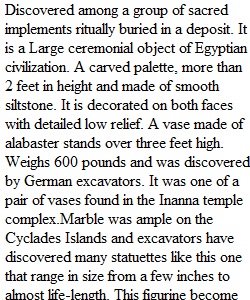


Q This assignment was locked Jun 5 at 11:59pm. • ART_101_11053FA22H • Assignments • Final Visual Essay. Identify and Write Instructor: C Fiddler Follow the link to download an editable copy of the Visual Text Final essay. Microsoft Visual essay link (Links to an external site.) Visual essay-To do (Links to an external site.) (Links to an external site.) Final essay (visual and text) (100)--5 points distribution per completed cell Read carefully and follow instructions. Do the following, go to your textbook find the picture, use its caption and what is written of it, copy and paste the printed information in the right text area of the text-box, directly across from the image. follow the example in the unnumbered table below. Do not remove images or re-arrange them. This essay page cannot be edited. To process, students must download one copy of the linked files above. The class textbook is needed to successfully complete this assignment. Have questions? Ask for help but do not turn in an assignment that is rushed or incomplete Do the following, go to your textbook find the picture, use its caption and what is written of the picture, copy and paste the printed information of the picture in the right text area of the text-box of the images derived from the textbook. follow the example in the unnumbered table below. Do not remove images or re-arrange them. Do not edit or remove images or re-arrange them. Please download a copy, Microsoft Visual essay link (Links to an external site.) Visual essay-To do (Links to an external site.) to edit the assignment and upload your edited copy to the assignment Final essay document layout Slide numbers Slides Do not write here Your dialog goes in this column Pay attention! This is an Example Venus of Willendorf quote, Fred S Kleiner, Gardeners, Art through the Ages, The Western Perspective, volume 1. Paragraphs 1-2. One of the oldest and most famous Paleolithic female images is the tiny limestone figurine of a woman that long ago became known as the Venus of Willendorf (fig. 1-4) after its findspot (place of discovery) in Austria. Its cluster of almost ball-like shapes is unusual, the result in part of the sculptor's response to the natural shape of the stone selected for carving. The anatomical exaggeration has suggested to many observers that this and similar statuettes served as fertility images. But other Paleolithic figurines depicting women with far more slender proportions exist, and the meaning of these images is as elusive as everything else about the world's earliest art. Yet, the preponderance of female over male figures seems to indicate a preoccupation with women, whose child-bearing capabilities ensured the survival of the species. One thing at least is clear: the Venus of Willendorf sculptor did not aim for naturalism (fidelity to nature) in shape and proportion. As is true of most Paleolithic figures, the sculptor of this woman did not carve any facial features. 1. Narmer's palette 2. Warka vase 3. Woman from Syros 4. Temple of Hera 5. Tomb of Khnumhotep 6. River near Nîmes 7. Old Saint Peter’s 8. Virgin of Compassion 9. Seljuk Friday Mosque 10. 11. 12-33 West facade of Saint-Étienne, Caen, France, begun 1067. 12. Röttgen Pietà, from the Rhineland, Germany, ca. 1300–1325. Painted wood, 2' 10 1 2" high. Rheinisches Landemuseum, Bonn. 13 Bihzad, Seduction of Yusuf, folio 52 verso of the Bustan of Sultan Husayn Mayqara, from Herat, Afghanistan, 1488. Ink and color on paper, 11 7 8" × 8 5 8". National Library, Cairo. 14. Mausoleum of the Samanids (looking west), Bukhara, Uzbekistan, early 10th century 15 Corinthian Black-figure amphora with animal friezes, from Rhodes, Greece, ca. 625-600 BCE. 1’2” high. British Museum, London. 16. Dome of the Rock (looking east), Jerusalem, 687–692 17. Male harp player, from Keros (Cyclades), Greece, ca. 600-2300 BCE Marble, 9” high. National Archaeological Museum, Athens. 18. Anthemius of Tralles and Isidorus of Miletus, Hagia Sophia, 532-537 CE. 19. Interior of Speyer Cathedral (looking east). Speyer, Germany, begun 1030, nave vaults, ca. 1082-1105. 20. Christ enthroned with saints (Harbaville Triptych), ca. 950. Ivory, central panel 9 1 2" × 5 1 2". Musée du Louvre, Paris Next
View Related Questions